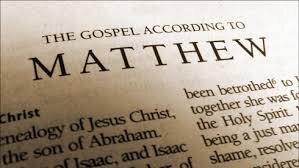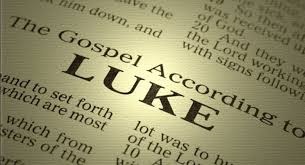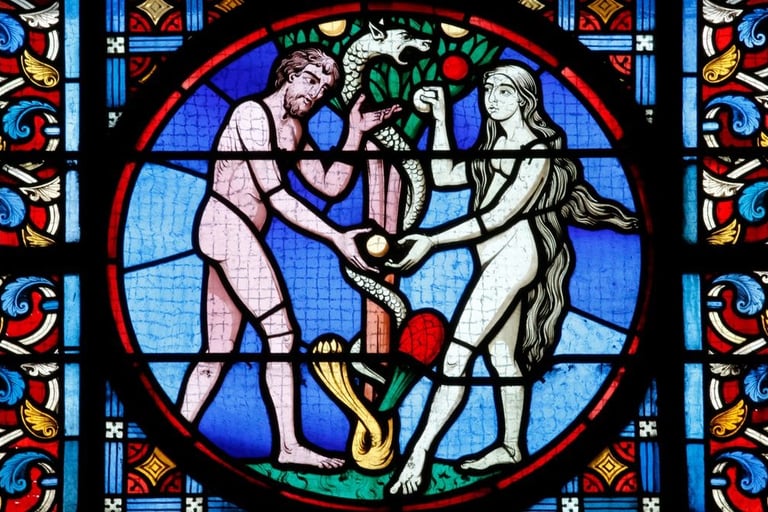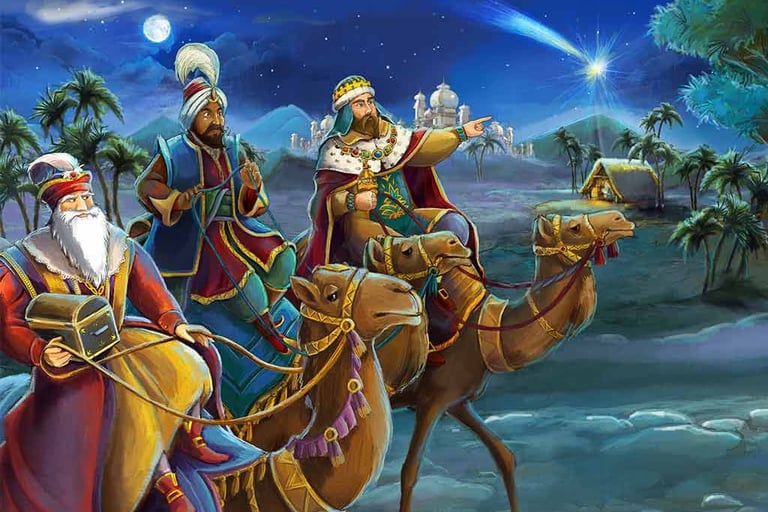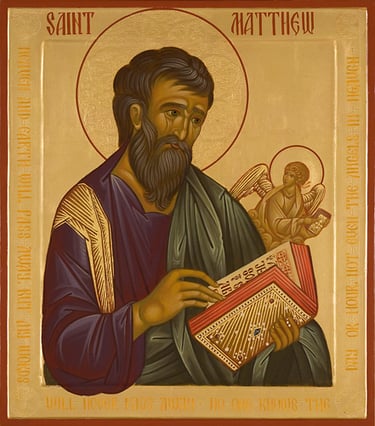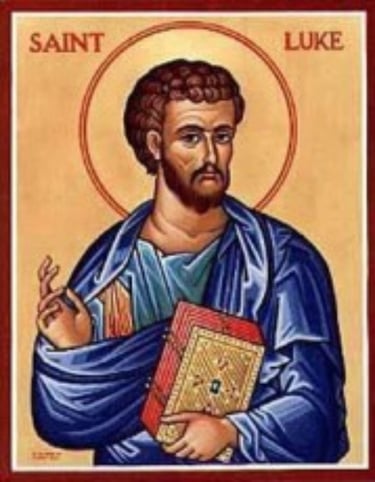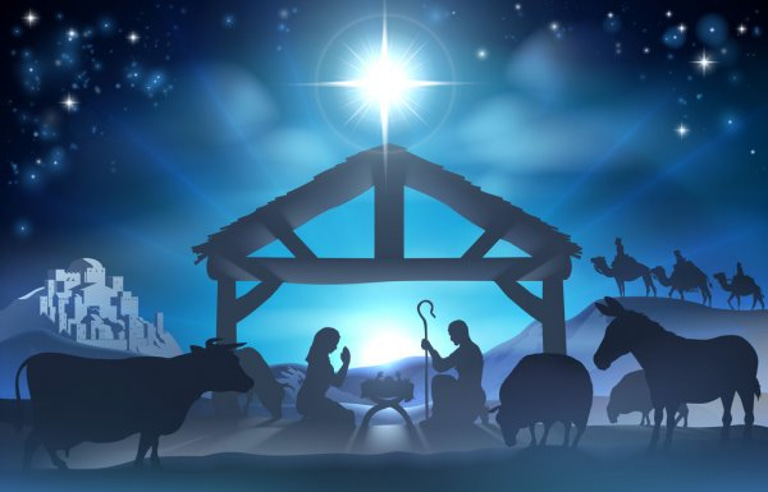Exploring Themes in the Nativity: Matthew and Luke Compared
Compare the Nativity stories in Matthew and Luke. Discover key similarities, differences, and rich meanings. Start your exploration now.
Grace Callahan
2/8/202513 min read
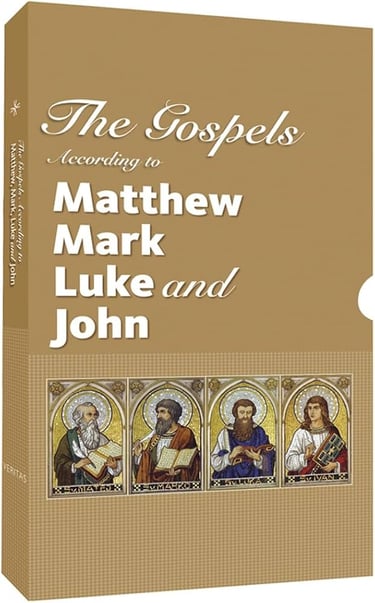

Introduction
The Nativity story is cherished by many, but the accounts in Matthew and Luke present it in unique ways. Each Gospel offers a different view of Jesus' miraculous birth, emphasizing different characters, events, and messages. This article will compare the nativity narratives from Matthew and Luke, exploring their distinct details and historical contexts. By examining these perspectives, we can gain deeper insights into early Christian beliefs and the significance of this profound story.
Overview of the Nativity Narratives
The birth of Jesus is one of the most well-known stories in history, yet the details we think we know often come from a blend of two distinct Gospel accounts—Matthew and Luke. Each tells the nativity from a different angle, shaped by their audience, purpose, and theological focus.
Matthew’s Nativity: A King in the Making
Matthew’s version is rich in Jewish symbolism and prophecy fulfillment, making it clear that Jesus is the long-awaited Messiah.
The genealogy comes first—tracing Jesus back to Abraham and David, solidifying His royal and prophetic credentials.
Joseph takes center stage. We see his dreams, his obedience, and his role in protecting the Holy Family.
The Magi (wise men) arrive, bringing gold, frankincense, and myrrh. Their visit signals Jesus’ significance beyond Israel, but it also stirs fear—King Herod sees Jesus as a threat, leading to the infamous Massacre of the Innocents and the flight to Egypt.
Matthew’s version isn’t just about a baby’s birth; it’s a political and prophetic drama filled with danger, divine guidance, and royal symbolism.
Luke’s Nativity: A Savior for All
Luke, writing for a broader Gentile audience, presents a more humble, inclusive, and deeply personal nativity.
The focus shifts to Mary—her encounter with the angel Gabriel, her visit to Elizabeth, and her powerful Magnificat (a song of praise highlighting God’s justice).
Instead of kings and prophecies, shepherds receive the birth announcement, emphasizing that Jesus came for the poor and marginalized.
There’s no dramatic escape to Egypt, but instead, a peaceful yet humble birth in a manger, reinforcing Luke’s themes of humility and divine grace.
Why Two Different Accounts?
Both Gospels tell the same core story—Jesus is the Messiah, born to bring salvation—but they tailor their details to different audiences.
Matthew: Written for Jewish readers, proving Jesus is the fulfillment of Old Testament prophecy.
Luke: Written for Gentiles, emphasizing Jesus’ universal mission of love and salvation.
The Bottom Line
If you’ve ever wondered why the Christmas story has both wise men AND shepherds, a stable AND a house, angelic visits to both Mary AND Joseph—now you know. These aren’t contradictions; they’re complementary perspectives, each adding depth to the nativity story we know today.
Genealogical Differences and Their Significance
The genealogies of Jesus in the Gospels of Matthew and Luke might seem contradictory at first glance, but they actually serve to highlight different aspects of His identity and mission. Each genealogy is carefully constructed to convey the theological message of its respective Gospel, and together, they provide a fuller picture of who Jesus is.
Matthew’s Genealogy: Jesus as the Jewish Messiah
Matthew’s genealogy traces Jesus' lineage through Joseph, focusing on His connection to King David and Abraham—two pivotal figures in Jewish history.
David: The Messiah was expected to come from David’s line, as prophesied in the Hebrew Scriptures (see 2 Samuel 7:12-16). Matthew emphasizes Jesus as the fulfillment of this royal prophecy.
Abraham: By tracing the lineage back to Abraham, Matthew connects Jesus to the covenant promises made to the patriarchs of Israel, solidifying His role as the fulfillment of God's promises to the Jewish people.
Matthew’s structure also emphasizes the number 14, which may symbolize completeness, reinforcing the idea that Jesus is the fulfillment of God’s divine plan in history.
For Matthew, the genealogy is a theological statement: Jesus is the promised Jewish Messiah, whose birth is deeply tied to Israel’s past. This underscores His Jewish identity and the fulfillment of Old Testament prophecies.
Luke’s Genealogy: Jesus for All Humanity
Luke’s genealogy presents a different lineage, tracing Jesus' ancestry back to Adam, not just to David or Abraham.
By starting with Adam, Luke emphasizes the universal nature of Jesus’ mission. Jesus isn’t just the Savior for the Jews; He is the Savior for all humanity—from the first human to the last.
This focus on universality reflects Luke’s broader theological perspective, which frequently emphasizes inclusivity and God’s love for the marginalized, such as women, Gentiles, and sinners.
Joseph’s lineage in Luke also diverges from Matthew’s, possibly reflecting a different tradition or understanding of Jesus’ earthly ancestry.
For Luke, the genealogy isn’t just about Jesus’ Jewish heritage—it’s about Jesus as the universal Savior, who came to redeem all people, regardless of ethnicity or background.
Theological Implications: What Do These Genealogies Tell Us?
Matthew presents a Jewish Messiah, highlighting Jesus as the fulfillment of specific prophecies and promises made to the people of Israel. His genealogy underlines Jesus’ role in salvation history as the continuation of God’s covenant with Israel.
Luke takes a broader, more inclusive view, emphasizing that Jesus' mission is not limited to the Jewish people. By connecting Jesus to Adam, Luke highlights that Jesus is the second Adam, bringing salvation to all of humanity, not just one ethnic or national group.
Both genealogies tell us something critical about Jesus' identity and role. Matthew connects Jesus to the royal, Jewish tradition, solidifying His role as the promised Messiah. Luke, on the other hand, reminds us that Jesus came for everyone—His salvation is for all of creation, from Adam to the ends of the earth.
The Bottom Line
While the genealogies in Matthew and Luke seem to tell different stories, they work together to paint a more complete portrait of who Jesus is: the Jewish Messiah, the Son of David, and the Savior of the World. It’s a beautiful reminder that Jesus’ story is not just a continuation of Israel’s history, but the beginning of a new story for all people.
Key Elements of the Birth Narratives
Both Matthew and Luke craft powerful stories about the birth of Jesus, but each Gospel has its own unique focus, highlighting different elements that reveal deeper theological truths. Let’s break down the key aspects of each narrative and what they reveal about Jesus’ birth.
Matthew’s Focus: The Messiah for the Nations
Matthew’s account is rich with symbolism, emphasizing the fulfillment of prophecy and the political implications of Jesus’ birth.
The Magi (Wise Men):
These Gentile visitors from the East follow a star to find the newborn King, bringing symbolic gifts—gold, frankincense, and myrrh.
Their journey represents a recognition of Jesus’ kingship not just by the Jews, but by the wider world. Their homage to Jesus is a powerful symbol of the universality of His mission.
The divine guidance they receive through dreams illustrates God's active involvement in the world's affairs, directing these non-Jewish figures to witness the birth of the Messiah.
Joseph’s Dream:
Joseph plays a crucial role in Matthew’s narrative, demonstrating incredible faith and obedience.
Through a dream, an angel reassures him not to fear taking Mary as his wife, fulfilling the prophecy from Isaiah 7:14 that the Messiah would be born of a virgin.
This highlights Joseph’s quiet, steadfast faith in God’s plan, a stark contrast to the turmoil and fear surrounding the birth of Jesus.
Herod’s Reaction:
King Herod’s paranoia and fear at the birth of Jesus is a political commentary on the threat the Messiah posed to earthly power structures.
This leads to the flight into Egypt, fulfilling another prophecy and ensuring the survival of the child. The violence of Herod’s actions underscores the threat Jesus’ kingship posed to worldly rulers.
Luke’s Focus: The Savior for the Humble
Luke’s narrative focuses more on the humble, inclusive nature of Jesus’ birth and the announcement of His coming to ordinary people.
The Annunciation:
The angel Gabriel’s message to Mary is central to Luke’s account, emphasizing Mary’s role in the incarnation.
Gabriel announces that Mary will conceive by the Holy Spirit, highlighting the miraculous nature of Jesus’ birth.
Mary’s response, “Let it be to me according to your word” (Luke 1:38), showcases her obedience and faith, making her an active participant in God’s plan of salvation.
The Shepherds:
Luke’s story places shepherds at the heart of the birth narrative, emphasizing the humble, lowly, and marginalized as the first to hear the good news.
The angelic announcement to the shepherds is filled with joy and immediacy, symbolizing the breaking in of God’s kingdom into the world.
The shepherds’ visit reflects the universal reach of Jesus’ mission, showing that the Savior’s birth is a cause for joy for all people, especially the lowly.
The Role of Angels:
Both Matthew and Luke include angelic messages, but the tone differs:
In Matthew, angels serve as guides and protectors—leading Joseph to safety and warning the Magi of Herod’s treachery.
In Luke, angels are celebratory, praising God and announcing the birth of the Savior to the shepherds.
In both cases, the angels serve as messengers of divine intervention, but with different emphases: guidance and warning in Matthew, joy and proclamation in Luke.
The Bottom Line
While Matthew and Luke each highlight different facets of the birth of Jesus, together they present a multifaceted picture of the Savior: a King for all nations (Matthew) and a humble Savior for the lowly (Luke). These contrasting yet complementary details remind us that Jesus’ birth is a moment for all people—from rulers to shepherds, from the learned to the humble.
Theological Themes and Literary Style
The birth narratives in Matthew and Luke are rich in theological depth and literary craftsmanship, reflecting the unique concerns of each Gospel writer. While they tell the same core story, the way they present that story and the themes they emphasize tell us a lot about how they viewed Jesus and His mission.
Matthew’s Narrative Style: Legitimacy and Prophecy
Matthew’s Gospel is structured with a strong emphasis on prophecy fulfillment, making it clear that Jesus is the promised Messiah foretold in the Old Testament.
Prophetic Fulfillment: Matthew often links events in Jesus’ life to Old Testament prophecies, reinforcing that Jesus’ birth, life, and mission were predicted long before. For example, Matthew’s genealogy connects Jesus to David and Abraham, two key figures in the Jewish faith.
Structured Legitimacy: The narrative builds Jesus’ legitimacy as the Messiah through various signposts: the fulfillment of prophecy, the visit of the Magi, the divine guidance given to Joseph, and the political threat posed by Herod. These all work together to show that Jesus is not just any child born into the world but the anointed one of Israel, the King promised to restore Israel.
Matthew’s style is concise, intentional, and designed to show that Jesus is the culmination of God's plan for Israel. Every detail serves to authenticate Him as the Messiah through references to the Hebrew Scriptures.
Luke’s Narrative Style: Compassion and Universality
Luke’s account, on the other hand, takes a more narrative-driven approach, focusing on the personal encounters and the compassionate nature of Jesus’ ministry.
Compassion and Inclusivity: Luke emphasizes the humble and marginalized in society—like Mary, the shepherds, and the poor—demonstrating that Jesus’ salvation is for everyone, not just the Jewish elite.
Personal Encounters: Luke's narrative is filled with personal divine interventions: Mary’s encounter with the angel Gabriel, the angelic announcement to the shepherds, and the joyous praise of Elizabeth. These encounters highlight God’s intimate involvement in the lives of ordinary people.
Detailed Account: Luke’s writing is more detailed, providing a clearer picture of the humble setting of Jesus' birth, including the journey to Bethlehem and the manger scene. This level of detail draws the reader into the narrative, making the story more accessible and relatable.
Luke’s style is warm, relational, and meant to convey the message that Jesus came not only for the Jews but for all people, with a special focus on those who are often overlooked or excluded by society.
Comparative Themes: Theological Implications
Messianic Prophecy:
Matthew consistently points to the fulfillment of Old Testament prophecies, showing that Jesus is the long-awaited Messiah. For Matthew, prophecy fulfillment is crucial in establishing Jesus’ legitimacy.
Luke, while aware of prophecy, focuses less on direct fulfillments and more on Jesus as the Savior for all. Prophecy is important, but Luke’s message is broader, showing that Jesus’ birth is not just for Israel but for the entire world.
Divine Intervention:
Matthew showcases angelic guidance and dreams as vital tools in ensuring Jesus’ protection and the fulfillment of divine purposes. For example, it is in dreams that Joseph receives guidance and reassurance.
Luke also includes angels, but their role in Luke’s narrative is more celebratory—announcing the birth of the Savior to the shepherds and proclaiming peace on earth. Divine intervention is portrayed as an immediate response to humanity’s need for salvation.
Social and Cultural Implications:
Matthew writes primarily for a Jewish audience, so his narrative emphasizes the Jewish identity of Jesus and His connection to Jewish prophecy. The themes are about God’s faithfulness to Israel and the coming of the Messiah who will redeem Israel.
Luke’s audience is more Gentile, so his focus is broader. His Gospel stresses the universal nature of Jesus’ mission, showcasing the inclusivity of the Kingdom of God. The marginalized are given a voice, and there is a clear call to embrace the grace and salvation that Jesus offers to all people, regardless of status or nationality.
The Bottom Line
Both Matthew and Luke are masterful storytellers, each with a unique theological lens through which they present the birth of Jesus. Matthew is concerned with legitimacy, prophecy, and royalty, emphasizing that Jesus is the Jewish Messiah. Luke, meanwhile, highlights compassion, universality, and personal encounters, stressing that Jesus’ mission is for the whole world.
These differences aren’t contradictions; rather, they complement each other, giving us a fuller picture of who Jesus is—the Jewish King and the Savior for all humanity.
Historical and Cultural Context
The birth narratives of Jesus in Matthew and Luke are not just stories; they are deeply embedded in the historical and cultural contexts of the time. The way each Gospel frames the story reflects the distinct concerns of the writers and their intended audiences, while also shaping early Christian thought and traditions.
Historical Setting in Matthew: A Jewish Milieu
Matthew writes his Gospel in a Jewish context, drawing heavily on the Old Testament and Jewish tradition to present Jesus as the Messiah and King.
Lineage and Prophecy:
The genealogy in Matthew traces Jesus’ lineage through David and Abraham, which resonates deeply with Jewish audiences who held these figures in high regard. The emphasis on fulfilling prophecy is crucial to Matthew’s message—Jesus’ birth is seen as a direct fulfillment of the Hebrew scriptures, confirming His identity as the promised King.
Political Implications:
The story unfolds against the backdrop of Roman occupation in Palestine, with King Herod representing the political tensions of the time. Herod’s threat to the newborn Jesus underscores the fear of a new king—a king who might challenge the authority of the ruling powers. For Matthew’s Jewish readers, this tension would resonate with their long-standing hopes for a deliverer who would restore the throne of David and free them from foreign domination.
In this context, Matthew’s narrative would have stirred hopes for political and religious freedom, presenting Jesus as a divine fulfillment of Israel’s promises in a world ruled by Roman authority.
Historical Setting in Luke: A Broader, More Inclusive Vision
Luke’s Gospel, by contrast, presents a more diverse social context, with a focus on poverty, social justice, and the marginalization of the poor.
Themes of Poverty and Social Justice:
The focus on Mary’s humble situation, the manger scene, and the shepherds is a deliberate choice that highlights the poverty of Jesus’ family and the social justice theme that runs throughout Luke’s Gospel. The birth of Jesus in such humble circumstances signals that God’s kingdom isn’t just for the wealthy or powerful but for the marginalized and the oppressed.
Universal Mission:
The inclusion of shepherds—who were considered lowly and unimportant in Jewish society—underscores the universal nature of Jesus’ mission. For Luke, Jesus’ coming is for everyone, especially those excluded or overlooked by society. The emphasis on Mary’s Magnificat, which proclaims that God has exalted the humble and brought down the mighty, aligns with Luke’s vision of a Kingdom of God that flips worldly expectations.
Luke’s account shows us that the Gospel is for all people, no matter their social status, nationality, or background. The inclusivity of this narrative would have been especially meaningful to Gentiles in the early church, reinforcing the idea that Jesus’ message was not limited to Jews alone.
Impact on Early Christian Thought
The historical and cultural contexts of Matthew and Luke had a profound influence on the development of early Christian doctrine and liturgical traditions, particularly surrounding the celebration of Christmas.
Matthew’s Influence on Early Christian Thought:
Matthew’s emphasis on prophecy fulfillment and Jewish heritage contributed to the early Christian understanding of Jesus as the Jewish Messiah. His genealogy would become a cornerstone in discussions about the Messiah’s lineage, which was central to debates about Jesus’ legitimacy among early Jewish followers.
Matthew’s portrayal of Herod’s threat also played into the persecution narrative in early Christianity, reinforcing the idea that the church would face opposition from political powers. This would later contribute to the martyrdom stories and the persecution many early Christians experienced.
Luke’s Influence on Early Christian Thought:
Luke’s emphasis on social justice and inclusivity resonated strongly with the growing Gentile church, helping to shape the understanding of salvation for all people. His portrayal of Jesus as a Savior for the lowly would inspire Christian social ethics, particularly in relation to the poor, the oppressed, and the marginalized.
The shepherds’ visit and the message of peace and goodwill would become central themes in the liturgical celebration of Christmas, influencing how Christians would later understand and commemorate the birth of Christ.
Conclusion: Integrating the Insights from Both Accounts
Matthew and Luke's nativity narratives present both differences and similarities that reveal the depth of Jesus' miraculous birth. While Matthew focuses on the lineage and the visit of wise men, Luke highlights the shepherds and the humble setting of the manger. Together, these accounts enrich our understanding of the Nativity, showing its significance for all people, both Jews and Gentiles. As you reflect on these diverse perspectives, consider how they enhance the universal message of hope and redemption. Embrace the fullness of this story and let it inspire your celebrations and faith journey.
